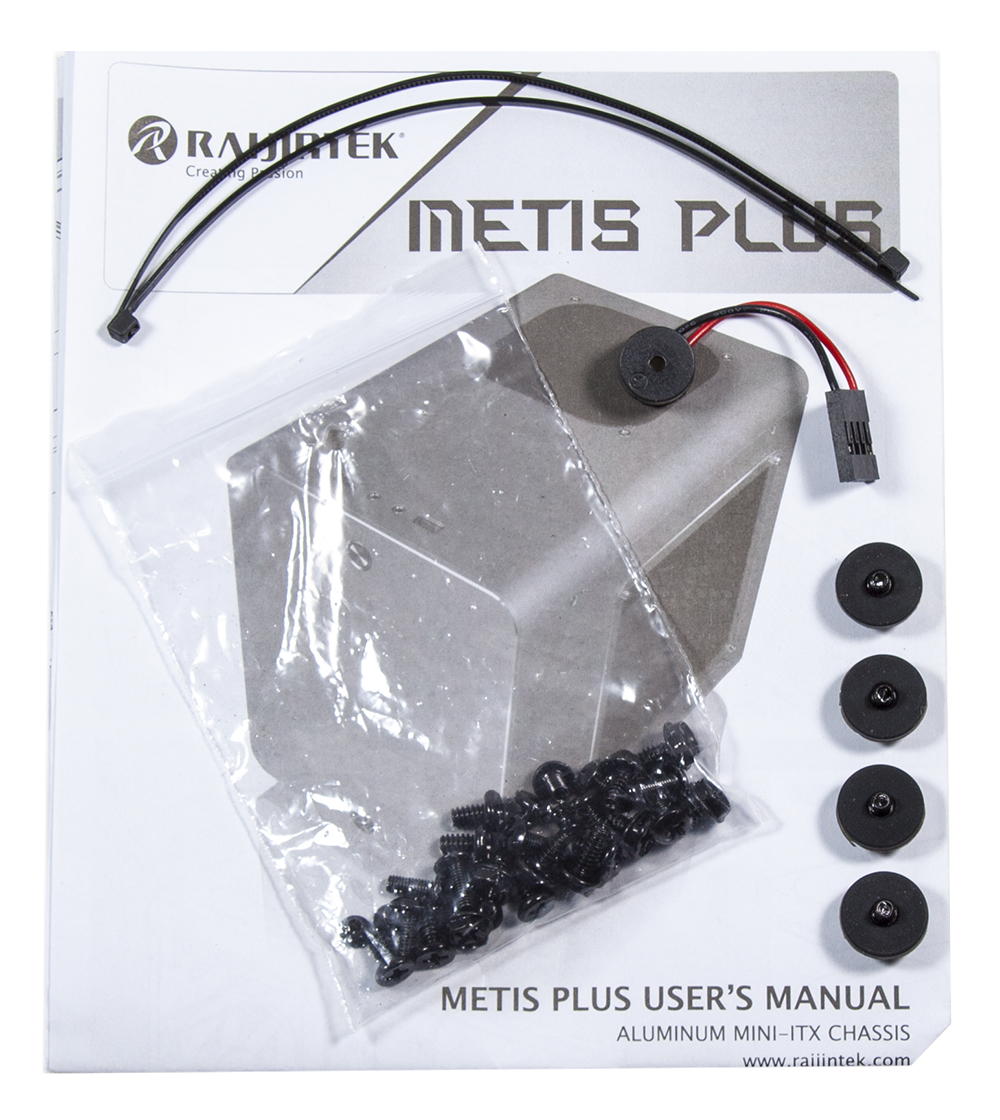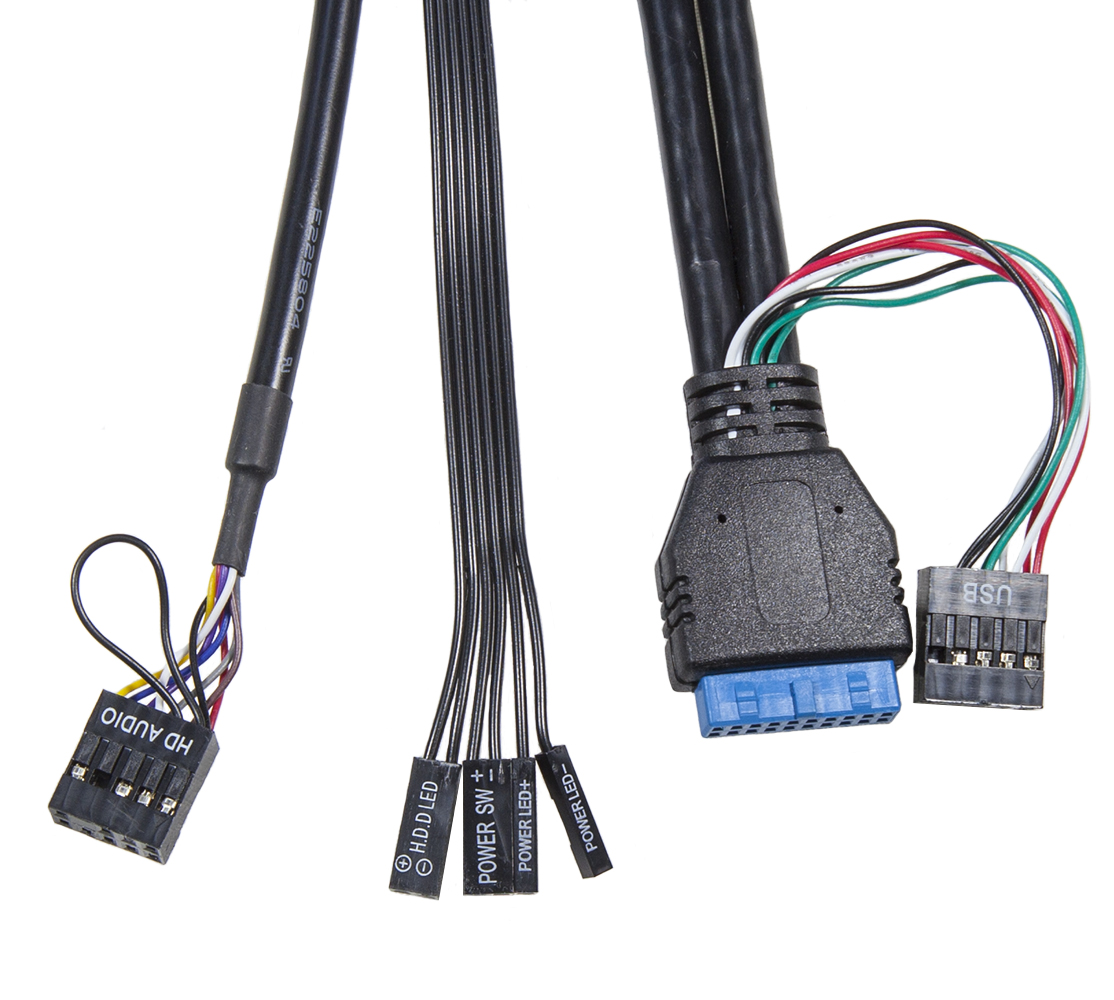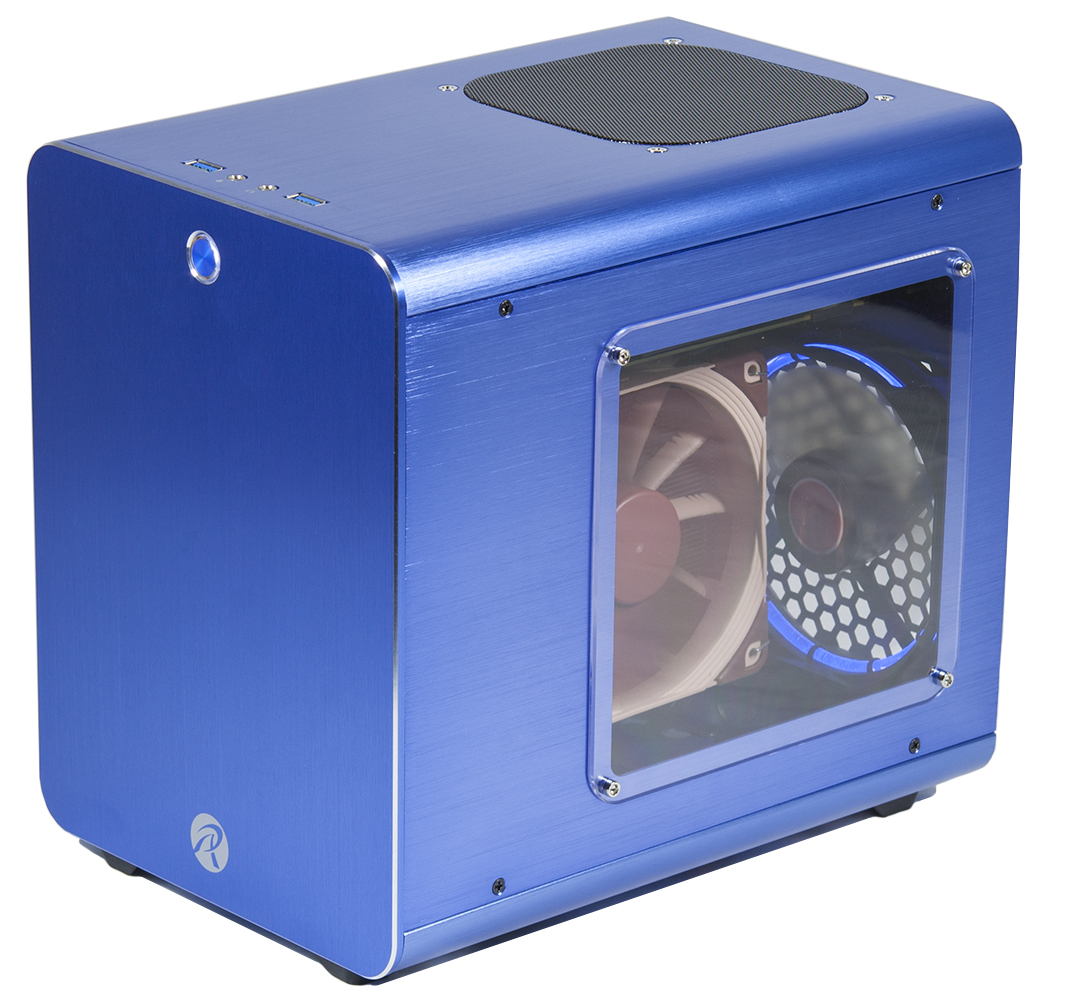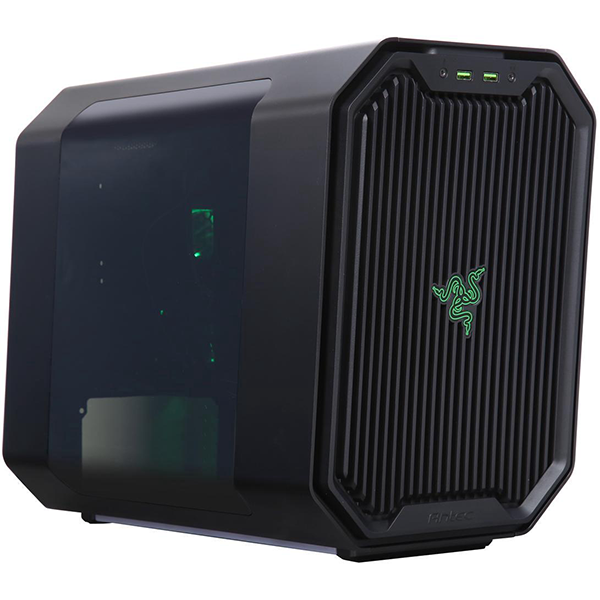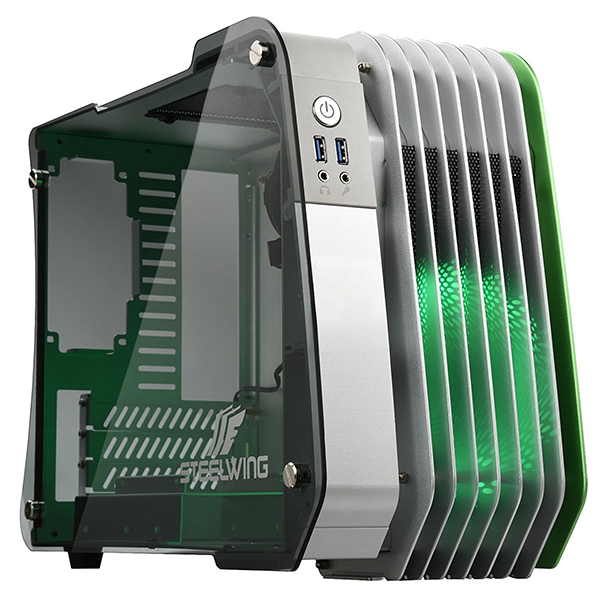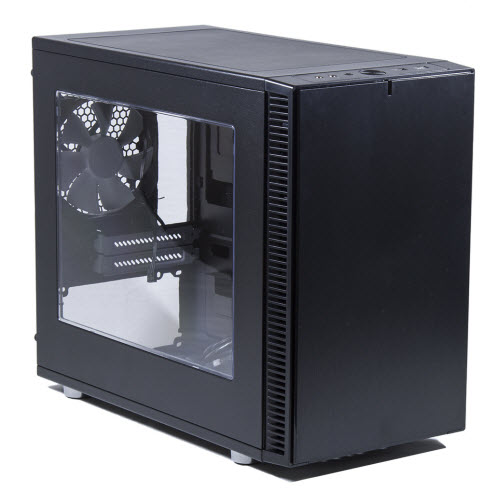Raijintek Metis Plus Mini ITX Case Review
Why you can trust Tom's Hardware
Hardware Installation & Test Configuration
The Metis Plus comes with the standard bag of screws along with an extra four drive screws and rubber vibration dampers for the motherboard tray mount, a small speaker, and a couple of cable ties.
The cable selection includes the standard front power and LED cables, as well as an HD Audio cable, and a USB 3.0 cable that also supports USB 2.0.
The Metis Plus puts almost every cubic inch of internal space to use, leaving little room for things like oversized components or cable management. Also worth mentioning is that while the vent on the top of the case is technically also a 120mm fan mount, its proximity to the expansion slots means that users have to choose between mounting a fan there or installing a graphics card into the expansion slots. But it’s still a convenient source of cool air for the graphics card and should improve the case’s performance in our benchmarks.
The small window on the Metis Plus provides just enough of a view to appreciate the good-looking parts of your build while keeping the power supply and excess cables just out of view. The LED fan at the rear of the case, while not overly bright, does give the case a nice glow in a dark or dimly lit room.
Today’s review uses the same Mini-ITX reference platform as past reviews, with no changes to the standard hardware.
Noise is measured .5m from the case's front corner, on the side that opens. The numbers are corrected to the 1m industry standard—used by many loudspeaker and fan manufacturers—by subtracting six decibels.
Additionally, the test duration for today’s review was four hours at full load, and the ambient air temperature for the test was maintained at approximately 26°C (78.8°F).
Get Tom's Hardware's best news and in-depth reviews, straight to your inbox.
Comparison Products
Test Configuration
Drivers and Settings
| Test System Configuration | |
|---|---|
| Sound | Integrated HD Audio |
| Network | Integrated Gigabit Networking |
| Software | |
| Graphics | Nvidia GeForce 353.30 |
| Chipset | Intel INF 10.0.27 |
| Benchmark Configuration | |
|---|---|
| Prime95 v27.9 | 64-bit executable, Small FFTs, 4 threads |
| 3DMark 11 | Version: 1.0.3.0, Extreme Preset: Graphics Test 1, Looped |
| Real Temp 3.40 | Average of maximum core readings at full CPU load |
| Galaxy CM-140 SPL Meter | Tested at 1/2 m, corrected to 1 m (-6 dB), dBA weighting |
MORE: Best Cases
MORE: All Case Content
Current page: Hardware Installation & Test Configuration
Prev Page Features & Specifications Next Page Benchmarks & Conclusion-
2Be_or_Not2Be How tall of a CPU cooler can you mount in this case? I see a low-profile one was used for the review, and it would nice to know the actual limits for the cooler height.Reply -
Brian_R170 I build a computer for my son using one of these in May 2017 when they first showed up at a few US online retailers. One of the coolest things about this case is that it can be completely disassembled with screws, but since almost all of them thread into aluminum, you need to be careful. I totally agree that Raijintek should've kept the option for a vented aluminum side like the original Metis Classic (the Metis Classic panel still fits this case, BTW). They also should just skip the ATX PSU mounting and make it SFX only. It's feasible to get an ATX PSU in there with a short "ITX" graphics card, but it's difficult to do without straining connectors, and it's certainly not pretty. With an SFX PSU, you can also easily fit longer graphics cards than Raijintek specs indicate. I found that creating a duct between the top vent and graphics card fan made a small but significant difference in GPU temp and reversing the rear fan to be an intake made an even bigger difference in CPU temp. The build is super clean using an SFX PSU with short modular cables, and ITX-length graphics card, and only M.2 storage, but it can quickly get messy from there.Reply -
2Be_or_Not2Be Reply20634142 said:I found that creating a duct between the top vent and graphics card fan made a small but significant difference in GPU temp and reversing the rear fan to be an intake made an even bigger difference in CPU temp.
So where is hot air exhausting? If the top vent is a duct to your GPU as an intake, the rear is also pulling air in, then where is the hot air going? Is it all going out through the PSU? If so, seems like the PSU's longevity might be shortened. Plus, that seems like it would create hot spots as the hot air will rise (unless somehow the air being pushed out by the GPU's fans - if it's not a blower-style venting out - is somehow creating a flow of air going down).
I see holes on the side where the motherboard would lie; however, that seems really inefficient as it's covered by the m/b.
-
Brian_R170 Reply20634801 said:So where is hot air exhausting? If the top vent is a duct to your GPU as an intake, the rear is also pulling air in, then where is the hot air going? Is it all going out through the PSU? If so, seems like the PSU's longevity might be shortened. Plus, that seems like it would create hot spots as the hot air will rise (unless somehow the air being pushed out by the GPU's fans - if it's not a blower-style venting out - is somehow creating a flow of air going down).
I see holes on the side where the motherboard would lie; however, that seems really inefficient as it's covered by the m/b.
The air gets pushed out through several places, including the side panel, the small vent in back, the ATX-SFX PSU adapter plate, and of course the PSU itself. The graphics card also vents at least 1/3 of it's hot air through it's own PCI slot bracket. The Corsair SF450 PSU is semi-passive and we have yet to even see the PSU fan turn on outside of running a torture test right after assembly. This is with a 65W i7-7700 CPU and Gigabyte GTX1070 mini. -
2Be_or_Not2Be Reply20637600 said:20634801 said:So where is hot air exhausting? If the top vent is a duct to your GPU as an intake, the rear is also pulling air in, then where is the hot air going? Is it all going out through the PSU? If so, seems like the PSU's longevity might be shortened. Plus, that seems like it would create hot spots as the hot air will rise (unless somehow the air being pushed out by the GPU's fans - if it's not a blower-style venting out - is somehow creating a flow of air going down).
I see holes on the side where the motherboard would lie; however, that seems really inefficient as it's covered by the m/b.
The air gets pushed out through several places, including the side panel, the small vent in back, the ATX-SFX PSU adapter plate, and of course the PSU itself. The graphics card also vents at least 1/3 of it's hot air through it's own PCI slot bracket. The Corsair SF450 PSU is semi-passive and we have yet to even see the PSU fan turn on outside of running a torture test right after assembly. This is with a 65W i7-7700 CPU and Gigabyte GTX1070 mini.
So are you using the vented side panel from the Metis "Classic" instead of the new one with the non-vented acrylic window? If so, my guess is that the vented side panel is where the majority of the hot air is exhausting.
I also agree with making a SFX PSU standard for this case. Internal space always helps when you're building a smaller case. -
Brian_R170 Reply20638019 said:So are you using the vented side panel from the Metis "Classic" instead of the new one with the non-vented acrylic window? If so, my guess is that the vented side panel is where the majority of the hot air is exhausting.
I also agree with making a SFX PSU standard for this case. Internal space always helps when you're building a smaller case.
No, I'm talking about the vents on the motherboard side. There is about a 7mm gap between the motherboard and the motherboard tray, plus another 2mm or so between the tray and the side panel. It's more than enough space for the air that can exit through the side panel holes. I know the airflow isn't ideal (like pretty much any SFF case), but we played around with it and this configuration keeps the critical components measurably cooler. Of course, setting it on carpet is a no-no because the feet can sink into the carpet and that blocks the bottom ventilation which is around half of the total exhaust surface area.
-
2Be_or_Not2Be Reply20638751 said:No, I'm talking about the vents on the motherboard side. There is about a 7mm gap between the motherboard and the motherboard tray, plus another 2mm or so between the tray and the side panel. It's more than enough space for the air that can exit through the side panel holes. I know the airflow isn't ideal (like pretty much any SFF case), but we played around with it and this configuration keeps the critical components measurably cooler. Of course, setting it on carpet is a no-no because the feet can sink into the carpet and that blocks the bottom ventilation which is around half of the total exhaust surface area.
Interesting. Well, it sounds like if you make the rear fan an intake, then you definitely should be running a SFX PSU.
Thanks for the info! I'm always on the lookout for good-performing mini-ITX cases. My go-to for a while has been Silverstone cases - like the old classic SUGO series. However, they can be a bit lacking in style for some (I'm personally okay with a clean, minimalist look). A nicely colored case can add a splash of style, though. -
Valantar A great review, even if this isn't the case for me. On that note: any plans for a review of the NZXT H200i in the near future? Even though I'd prefer a "silent" version (sound dampening in the top/rear/front, possibly a solid side panel), it's the top contender for my planned ITX move. Need a case that can fit my 240+120mm rads, a res and my Fury X, so it needs to have some volume, but preferably not too much. The Define Nano S is nice, but a bit boring-looking.Reply -
Flying-Q Reply
From their website they claim any CPU cooler up to 160mm in height.20633966 said:How tall of a CPU cooler can you mount in this case? I see a low-profile one was used for the review, and it would nice to know the actual limits for the cooler height.
-
2Be_or_Not2Be Reply20643371 said:
From their website they claim any CPU cooler up to 160mm in height.20633966 said:How tall of a CPU cooler can you mount in this case? I see a low-profile one was used for the review, and it would nice to know the actual limits for the cooler height.
Thanks! I wish all reviewers would be required to include this info when they review mini-ITX cases as it's pretty critical for the smaller form factor.
